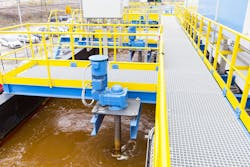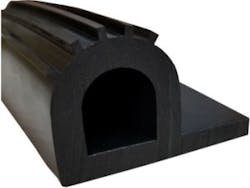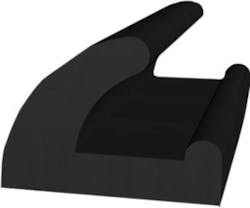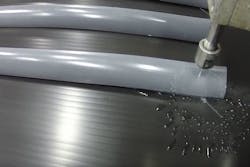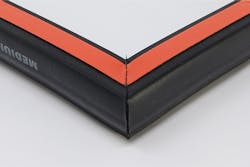Disinfection with ultraviolet light (UV) is a widely recognized and proven method for treating industrial wastewater in industries like food and beverage, microelectronics and oil and gas. When microorganisms such as bacteria, viruses and protozoa are exposed to UV light, the UV energy destroys their genetic material. This process, known as thymine dimerization, eliminates the pathogens’ ability to reproduce and cause infection.
Disinfection is not the same as sterilization, but exposure to UV light is effective against E.coli, Crytosporidiym, Giardia and other types of pathogens. For disinfecting water, UV light in the UV-C or shortwave UV band is used. This band or category of UV light is a form of electromagnetic energy that is invisible to the human eye and has a lower wavelength than sunlight. UV light for water treatment is also used in total organic carbon (TOC) reduction and the destruction of chlorines, chloramines and ozone.
UV disinfection is a physical rather than a chemical process, so it will not alter the water’s chemistry or add color, odor or taste. It is environmentally friendly, has a small footprint and offers low operational and maintenance costs. When designing a complete water filtration system, however, more than just UV lamps, quartz sleeves, ballasts and sensors are required. Equipment manufacturers need rubber gate seals. They also need to know some best practices for seal design, seal fabrication and seal replacement.
P-seals have a compressible bulb and a stem or tail for fastening the gasket to the gate.
J-seals do not need full compression to provide effective sealing in industrial
water treatment facilities.
Rubber gate seals design
In wastewater treatment facilities, metal gates are bolted to concrete frames to control the flow of water and to channel effluent for disinfection. To seal the gaps between the gates and frames, rubber gaskets are installed. These gate seals must withstand prolonged exposure to water, mechanical stress from tightened fasteners and abrasive contact with the concrete frames. Resistance to UV light is critical, of course, but gate seals may also need to resist a range of temperatures and specific substances.
Not all rubber compounds can meet these and other requirements. For example, natural rubber provides good resistance to tearing and fatigue, but will not resist prolonged exposure to the acids, greases and fats found in some industrial wastewater. Neoprene, a common synthetic elastomer, provides better resistance to environmental degradation and resists petroleum products. Nitrile rubber offers excellent oil and solvent resistance across a wide temperature range but is attacked by sunlight and ozone.
In addition to environmental resistance, gate seals require a durometer or hardness that supports long-term sealing. Rubber that is hard like a 90-durometer (Shore A) hockey puck will not compress enough to form a seal between the bottom of a metal gate and the concrete frame. Rubber that is soft like a 40-durometer pencil eraser may compress too much and fail to return to its original thickness when the compressive force is removed. Known as compression set, this phenomenon can cause seal failure.
The shape of the gasket also determines the success of a gate seal. Many rubber profiles are extruded into shapes that resemble letters. Examples include P-seals and J-seals. P-shaped seals have a rounded bulb and a flat stem. The bulb provides sealing when it is compressed. The stem or tail is used for attaching the gasket to the frame. J-seals have an edge or extended lip instead of a rounded bulb. Unlike P-seals, J-seals do not need full compression to provide effective sealing.
Water-jet cutting does not require expensive metal tooling and makes precise holes for fastener heads.
Seal fabrication
Rubber gate seals for industrial water filtration systems can be made by cutting standard profiles to size and then bonding the cut ends into finished gaskets. Manual cutting can be performed by the equipment manufacturer or even on-site at a water treatment facility. However, a gate seal that is cut with hand tools may lack smooth lines or have undersized or oversized bolt holes. Plus, cut lengths with uneven edges can be difficult to splice or bond. Material waste from mis-cuts can add unnecessary expenses, too.
Choosing the right bonding process for the gate seal is also important. Hot splicing uses heat, pressure and a thin polyethylene (PE) film splice to join the ends of cut lengths. It requires clean, straight cuts but accommodates larger profiles and requires less post-production trimming. With newer bonding equipment, fast-acting infrared light (IR) can be used as the heat source. Most film splices are 90 degrees, but hot splicing also supports 45-degree miter cuts. With IR splicing, no adhesives are required.
Infrared splicing requires clean, straight cuts, but accommodates larger rubber profiles.
Cold bonding is a joining technique performed with a paint brush and glue. It is called cold because heat is not applied to the ends of the gasket. Cold bonding does not require tooling, so it supports the cost-effective production of small volumes. Some glues crystallize when they contact water, however, and all glues dry out over time. Glues can also fail if the surface of the rubber is not prepared properly or if the application’s service temperatures are extreme.
Molding, another gasket bonding technique, produces stronger joints than hot splicing and provides greater resistance to leaking. Plus, it is the only bonding technique that can create rounded corners for rubber gaskets. Molding is also recommended for corners that will be stretched or pulled, yet molding requires tooling and C-press injection molding equipment. The cost of a metal mold can be significant, so molded gaskets are generally reserved for high-volume production.
Rubber gaskets that are water-jet cut and infrared spliced can be taped for ease of installation.
Seal replacement
When gate seals require frequent replacement, manufacturers of industrial water filtration systems may decide to redesign or replace existing rubber parts. Such was the case when an equipment manufacturer asked Elasto Proxy, a gasket fabricator, to replace a low-volume quantity of rubber gate seals used with its UV disinfection systems. The manufacturer’s current part, a large P-shaped profile, was made of natural rubber and measured nearly 2 inches high and 4 inches wide.
To ensure the amount of compression required with P-seals, this hard rubber gasket had a hollow center, yet the gate seal still required a significant amount of compressive force. Because the seal’s corners were joined with cold bonding, the manufacturer wanted stronger joints. There were no industry standards or regulations that required natural rubber as the sealing material, and even the shape of the gasket itself could be changed to improve sealing performance.
Given these parameters, the gasket manufacturer recommended a 60-durometer J-seal made of ethylene propylene diene monomer (EPDM), a synthetic elastomer. Unlike natural rubber, EPDM provides excellent UV resistance. EPDM also withstands abrasion, a range of service temperatures and prolonged contact with water. A 60-durometer seal does not require significant compressive force, and a J-seal can provide effective sealing without full compression. The manufacturer accepted the gasket fabricator’s recommendations and requested a sample.
Using water-jet cutting equipment, Elasto Proxy produced a prototype gate seal with the required bolt hole pattern. Unlike manual cutting, water-jet cutting makes clean cuts, including small holes. Unlike die-cutting, another machine-based cutting method, water-jet equipment does not require metal tools called dies. In addition to prototyping, water-jet cutting is ideal for low- to medium-volume production. Gasket bonding for this project was achieved with IR splicing, which is a good choice for larger gaskets.
Conclusion
Wastewater professionals and manufacturers of industrial water filtration systems need to consider many factors when designing or replacing rubber gate seals. Choosing an environmentally resistant rubber is important, but so is selecting the right shape for the seal. The hardness or durometer of the elastomer also affects performance. Gasket fabrication techniques that support smooth lines, tight holes, strong bonds and larger-sized parts also drive the success of sealing solutions.
